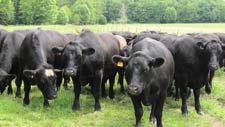“The biggest difference between me and another butcher, say, in a grocery store, is I’m taking a whole [animal] carcass and breaking it down into subprimals. And, then taking it down further into cuts, where they are getting those subprimals out of a box”—Tracy Smaciarz, artisan butcher
After butchering upwards of 10,000 carcasses in his life, Tracy Smaciarz can consistently tell “the quality of the meat, the taste, the texture, and the smell” from each new carcass that arrives at his shop.
As owner of Heritage Meats, an artisan butcher shop that “specializes in organic, locally grown and sustainable meat products and services,” Tracy Smaciarz can also tell a lot about a particular animal by visiting them at the farm. “I can tell you when to slaughter them and why to slaughter them based on the portion sizes that you’re going to get out of those cuts of meat,” says Smaciarz.
As we see in the video, Smaciarz visits one of his client’s, Tracey Baker of The Gleason Ranch, where they both emphasize the importance of quality care and treatment that her grass fed cattle receive. While grass fed beef is growing in popularity for both health reasons and for desired taste, it generally takes an extra 6 months time to bring grass fed cattle to market size, which obviously is an added cost. According to Smaciarz, in grass fed operations, the quality of the finished meat comes down to “the feeding, the genetics [of the animal], and the meat processing side”, all three must be done well, in order to end up with a “great product”. From both the rancher and butcher perspective, working together as a team, they have strong incentives to do everything they can the right way.
Smaciarz, a second generation butcher, sees his profession as an endangered species, but one he hopes will come back.
“It’s my father that started the business, and I’m very proud of my father, and my family. I fell in love with the business because of the people I work with, and the people I have working for me”.
Most of the videos featured on Cooking Up a Story were produced, filmed, and edited by Rebecca Gerendasy. Fred Gerendasy contributed as a writer to many of the posts and occasionally as the interviewer. Visit Rebecca Gerendasy Clay – Art and Fred Gerendasy Photography to see their current work.

